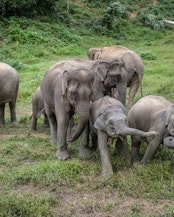Biodiversity conservation innovations

Biodiversity conservation innovations
- Our Objective
This project is developing new approaches toward elephant and habitat conservation, maximizing co-benefits for nature and people in a financially sustainable manner. The project partners with the Elephant Conservation Center (ECC), a private-sector organization in Xayabury province, Laos, exploring new ways for the ECC to diversify their income beyond eco-tourism. The project will also support the ECC in building new conservation partnerships, enabling the organization to expand their elephant care, monitoring, and rewilding activities. Through the ECC, the project also aims to foster engagement with local schools and communities and enhance our conservation efforts in the Solutionscape.
- Figures
The project was launched on June 1, 2023 and is currently in progress.
Summary
The Elephant Conservation Center (ECC) is a leader in eco-tourism in Xayabury and across Laos. The ECC holds a 540-hectare land concession, 70% of which is forested. Over the last 15 years, it has generated valuable data sets and provided a sanctuary for both wild and captive elephants in Laos. However, the center has struggled economically after the pandemic due to limited income streams to support its important work in conservation and local capacity building. Given ECC’s significant efforts around the Nam Tien protected area, collaborating with and supporting the ECC is integral to elephant and forest conservation.
The project supports the development of the Education, Conservation & Research (ECORE) initiative with the ECC, providing local, regional, and international researchers with a base for medium- and long-term studies that use the ECC’s unique setting. The long-term goal is to develop the ECC into a regional facility for research in conservation and the environment, including agriculture and forestry. Another aim is to further develop research areas with local and international partners, using the concession site and the protected area around Nam Tien reservoir as the main site for research. ECORE will not only generate new research and findings, but also allow for North-South research partnerships, exchange and capacity building. This includes collaborating with Lao educational institutions, supporting local students, and integrating conservation efforts with local communities, which is another priority of ECORE.
Project Connections
- Part of the solutionscape
Ensuring forest stewardship and restoration at cash crop frontiers
Timeline
Where Elephants Lead: A Journey into Systems Transformation in Laos
Project Update July 31, 2025
One of the most impactful stops along the journey was the visit to the Elephant Conservation Center (ECC) in Xayabury, marking the first official educational visit to the Center’s Education, Conservation & Research (ECORE) program. At the ECC, students were introduced to pressing environmental challenges such as the expansion of monocrop-driven agriculture, which threatens forest biodiversity and traditional land-use systems.This issue was contextualized within the broader work of our Hub Southeast Asia’s Solutionscape, a collaborative approach focused on developing solutions that protect and restore nature while supporting the people who depend on the land and its resources.
Connecting Academia and Conservation with the Elephant Conservation Center in Laos
Project Update December 10, 2024
Elephants are a keystone species. They play a major role in the ecosystem, they open pathways for smaller plants to grow as they make their way in the forest, their dung disperses seeds, and their existence ensures biodiversity. Culturally, elephants have been a sacred national symbol in Laos. A few centuries ago, Laos was named “Land of a Million Elephants,” but now there are only 800 captive and wild elephants left in the country (according to the ECC). Deforestation in Laos has led to the loss of wildlife habitats and human-wildlife conflicts, and the logging ban has left many mahouts out of work, and without income to take care of their elephants.The Elephant Conservation Center (ECC) is a key player in elephant conservation in Laos, managing over 30 elephants across a 540-hectare reserve and the adjacent National Park. The Wyss Academy for Nature’s Hub Southeast Asia realized the importance of balancing between nature and human wellbeing and has partnered up with the ECC since early 2023 to explore and test multiple conservation efforts. One such effort is to provide local, regional and international researchers with a base for medium and long-term studies, utilizing the ECC’s unique setting and supporting the Education, Conservation & Research (ECORE) initiative. As a scientific basecamp for students and researchers, ECORE aims to drive research and connect scientific studies with social science and community development.
A greener future
Project Update February 28, 2024
Zum ersten Mal seit mehr als drei Jahren konnten Schulkinder aus einer abgelegenen Region in Laos das international renommierte Elephant Conservation Center (ECC) besuchen, das nur wenige Kilometer von ihrem Wohnort entfernt liegt.Während der Covid-19-Pandemie konnte das ECC keine Besucher*innen empfangen. Die finanziellen Folgen der Schliessung zwangen das Team, sich darauf zu konzentrieren, die Gesundheit und Sicherheit der 30 Elefanten zu gewährleisten, die im Nam-Tien-Schutzgebiet zu Hause sind. Nun intensiviert das ECC mit Unterstützung der Wyss Academy das Engagement in den lokalen Gemeinschaften. Dies spielt eine entscheidende Rolle für das Schicksal des Waldes, von dem die Elefanten abhängen.Das oft bemühte Klischee „Die Zukunft gehört den Kindern“ trifft in Laos ganz besonders zu, wo mehr als 50 Prozent der Bevölkerung jünger als 25 Jahre sind. Wie in anderen Teilen der Welt wird das Einkommen, mit dem ländliche Familien bessere Häuser bauen und ihren Kindern den Schulbesuch ermöglichen, häufig auf Kosten der Umwelt erwirtschaftet. Wälder werden zerstört, Flüsse verschmutzt und Böden ausgelaugt. Für die nächste Generation von Bäuer*innen in Laos bedeutet dies, dass sie nicht denselben Weg einschlagen können wie ihre Eltern. Viele werden ihre Dörfer verlassen wollen, doch jene, die bleiben, müssen eine andere, grünere Zukunft für sich gestalten.Die ländlichen Schulen sind sowohl Keimzelle für Wissen und Haltungen, die das Leben der nächsten Generation von Bäuer*innen prägen werden, als auch Treffpunkt für den Austausch in der Gemeinschaft. In der Provinz Sayaboury, in den Dörfern in der Nähe des Nam-Tien-Schutzgebiets, unterstützt die Wyss Academy ein Netzwerk von Lehrpersonen, um ein nachhaltiges Miteinander mit der Natur in ihren Schulen zu fördern. Dazu gehören umweltpädagogische Aktivitäten im Klassenzimmer und während der Besuche des ECC sowie Verbesserungen im Abfallmanagement der Gemeinden.Ein nachhaltiges Miteinander mit der Natur lässt sich nicht über Nacht erreichen. Ein ausgewogenes und nachhaltiges Zusammenspiel zwischen menschlichen Aktivitäten und der Natur erfordert anhaltende Anstrengungen auf allen Ebenen der Gesellschaft. Wenn Kinder durch den Wald geführt werden und den Elefanten begegnen, deren Fressgewohnheiten, Bade-Rituale und fürsorgliches Verhalten gegenüber ihren Jungen beobachten, entsteht eine inspirierende und unvergessliche Erfahrung. Es ist eine Begegnung zwischen zwei Spezies, die auf dem Weg in eine grünere Zukunft bessere Partner werden müssen.
Happy elephants and happy people
Project Update December 13, 2023
Situated near Sayaboury town in Laos, Nam Tien Provincial Protected Area spans 6,000 hectares. It has been home to the Elephant Conservation Center (ECC) since 2010. The Nam Tien area provides a secure habitat for 10% of the country's captive elephants. Maintaining a healthy captive population in Laos is considered crucial, both by the Government of Laos and the conservation community, as it represents a vital resource that can help strengthen the country’s remaining wild elephant population. The ECC's rewilding program relies on the availability of elephants of breeding age capable of forming strong social bonds before their eventual release.But the elephants are frequently disturbed: The Nam Tien area has been facing encroachments in the form of large-scale agriculture, such as bananas and watermelon. Additional disturbances, like karaoke boats on the lake, are increasing, underscoring the vulnerability of conservation measures when faced with lucrative businesses.In January 2023, the Wyss Academy for Nature established a partnership with the Elephant Conservation Center to test and implement various innovative approaches to the conservation of both species and habitats. Their long-term sustainability is ensured by the fact that they also bring benefits for communities. The measures include a mahout-to-ranger program in which traditional and scientific knowledge are combined, and the piloting of a new research-based business model for conservation focused on eco-tourism. In addition, the ECC reaches out to local communities with environmental- and conservation-focused education programs.
Team
- Project contactProject contact
Dr. Horst Weyerhäuser
Hub Director
Other Projects in this Solutionscape
Nature-positive land use and livelihood development
Nature-positive land use and livelihood developmentStewardship at forest frontiers—Co-designed knowledge and engagement
Stewardship at forest frontiers—Co-designed knowledge and engagementStakeholder network analysis for systemic transformation
Stakeholder network analysis for systemic transformation








